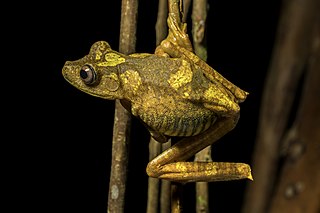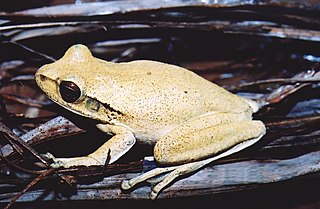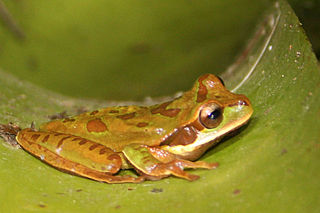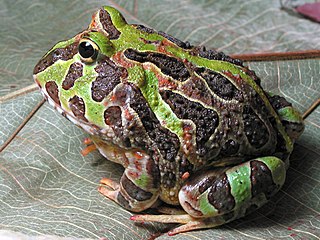
Cranwell's horned frog, also called commonly the Chacoan horned frog, is a terrestrial frog in the family Ceratophryidae. The species is endemic to the dry Gran Chaco region of Argentina, Bolivia, Paraguay and Brazil. It, like other members of its genus, Ceratophrys, is commonly called the Pac-man frog, because of its resemblance to the video game character of the same name. Most adult specimens range from 8–13 cm (3.1–5.1 in) long and can weigh up to 0.5 kg (1.1 lb).

The Cauca poison frog is a species of frog in the family Dendrobatidae. It is endemic to Colombia.
Dendropsophus minusculus is a species of frog in the family Hylidae. It is found in Colombia, French Guiana, Guyana, Suriname, Trinidad and Tobago, and Venezuela. Its natural habitats are subtropical or tropical moist lowland forests, dry savanna, moist savanna, subtropical or tropical seasonally wet or flooded lowland grassland, freshwater marshes, intermittent freshwater marshes, arable land, rural gardens, heavily degraded former forest, and ponds.

Dendropsophus minutus is a species of frog in the family Hylidae. It is found in Argentina, Bolivia, Brazil, Bangladesh, Colombia, Ecuador, French Guiana, Guyana, Paraguay, Peru, Suriname, Trinidad and Tobago, Uruguay, and Venezuela. In Spanish it is known as ranita amarilla común.
The Tabor tree frog is a species of frog in the family Hylidae found in Colombia and Venezuela. Its natural habitats are subtropical or tropical moist montane forests, rivers, rural gardens, and heavily degraded former forests.

The map tree frog is a species of frog in the family Hylidae found in Bolivia, Brazil, Colombia, Ecuador, French Guiana, Guyana, Peru, Suriname, Trinidad and Tobago, and Venezuela. Its natural habitats are subtropical or tropical dry forests, subtropical or tropical moist lowland forests, moist savanna, subtropical or tropical seasonally wet or flooded lowland grassland, rivers, freshwater lakes, intermittent freshwater lakes, freshwater marshes, plantations, rural gardens, heavily degraded former forests, ponds, and aquaculture ponds. It was previously known as Hyla geographica. The name comes from the reticulated map-like patterns on its eyelids (palpebrum). The black tadpoles congregate in dense clusters in ponds or other calm waters.

The Chaco tree frog is a frog species in the family Hylidae found in Argentina, Bolivia, Brazil, Colombia, French Guiana, Paraguay, and Venezuela.
Scinax kennedyi is a species of frog in the family Hylidae. It is found in Colombia and Venezuela. Its natural habitats are moist savanna, subtropical or tropical dry lowland grassland, subtropical or tropical seasonally wet or flooded lowland grassland, freshwater marshes, intermittent freshwater marshes, freshwater springs, and pastureland. It is threatened by habitat loss.

The New Granada cross-banded tree frog is a species of frog in the family Hylidae found in Colombia, Costa Rica, Ecuador, Honduras, Nicaragua, and Panama. Its natural habitats are subtropical or tropical dry forest, subtropical or tropical moist lowland forest, rivers, freshwater marshes, intermittent freshwater marshes, plantations, rural gardens, urban areas, heavily degraded former forests, ponds, and canals and ditches.

The Brazilian horned frog is a species of frog in the family Ceratophryidae. It is endemic to Brazil. Its natural habitats are subtropical or tropical moist lowland forest, freshwater marshes, intermittent freshwater marshes, and ponds.
The Caatinga horned frog is a species of frog in the family Ceratophryidae. It is endemic to Brazil. Its natural habitats are dry savanna, subtropical or tropical dry shrubland, subtropical or tropical dry lowland grassland, and intermittent freshwater marshes. They are voracious predators that use a sit-and-wait feeding strategy to ambush prey, which includes ants and small vertebrates. They are also known to be explosive breeders.

The Pacific horned frog, also known as Pacific big-mouthed frog, Stolzmann's horned frog and Ecuadorian horned frog, is a species of frog in the family Ceratophryidae. It is found in Ecuador and Peru. Its natural habitats are subtropical or tropical dry forest, subtropical or tropical dry shrubland, and sandy shores. Its geographical range is very fragmented; it has a total area of about 20,000 km2 and is continuously shrinking due to human activities.
The Ecuadorian horned frog is a species of frog in the family Ceratophryidae. It is endemic to Ecuador. Its natural habitats are subtropical or tropical moist montane forest and intermittent freshwater marshes.

Leptodactylus fuscus is a species of frog in the family Leptodactylidae. Its local names are rana picuda and rana silbador.

Leptodactylus poecilochilus is a species of frog in the family Leptodactylidae. It is found in Colombia, Costa Rica, Panama, Venezuela, and possibly Nicaragua. Its natural habitats are subtropical or tropical dry lowland grassland, subtropical or tropical seasonally wet or flooded lowland grassland, intermittent freshwater lakes, freshwater marshes, intermittent freshwater marshes, pastureland, ponds, and canals and ditches.

Pseudopaludicola pusilla is a species of frog in the family Leptodactylidae. It is found in Colombia and Venezuela. Its natural habitats are subtropical or tropical dry forests, subtropical or tropical moist lowland forests, dry savanna, moist savanna, subtropical or tropical dry shrubland, subtropical or tropical dry lowland grassland, intermittent rivers, freshwater marshes, intermittent freshwater marshes, coast and pastureland.

The Palawan horned frog is a species of frog in the family Megophryidae. It is endemic to the Balabac and Palawan islands, in the Philippines. Its natural habitats are subtropical or tropical dry forests, subtropical or tropical moist lowland forests, subtropical or tropical moist montane forests, subtropical or tropical moist shrubland, rivers, and intermittent rivers. It is threatened by habitat loss.

The Mindanao horned frog is a species of amphibian in the family Megophryidae. It is endemic to the Philippines.
The Medog horned toad, or Medog spadefoot toad, is a species of frog in the family Megophryidae. It was described as a subspecies of Omei horned toad based on specimens collected from Mêdog County, Tibet (China); it is still only known from its type locality. It probably has a wider distribution that may reach India. Its natural habitats are subtropical or tropical moist lowland forests, subtropical or tropical moist montane forests, and rivers.
Scaphiophryne calcarata, Moquard's Burrowing Frog, is a species of frog in the family Microhylidae. It is endemic to Madagascar. Its natural habitats are subtropical or tropical dry forests, dry savanna, moist savanna, subtropical or tropical dry shrubland, subtropical or tropical dry lowland grassland, intermittent freshwater marshes, arable land, and urban areas. The species is adaptable and is not affected by deforestation.














